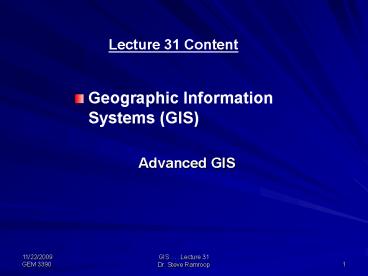GEM 3390 PowerPoint PPT Presentation
1 / 13
Title: GEM 3390
1
Lecture 31 Content
- Geographic Information Systems (GIS)
- Advanced GIS
2
- Fuzzy sets
- Operations
3
- What is fuzzy sets?
- GIS inception we assumed everything to be
delineated using a distinct point, line and area - Uncertainty was treated using statistical methods
- New approach in dealing with uncertainty,
complexity, and vagueness in terms of fuzzy sets
4
- Basic laws of thought by Aristotle
- The law of identity (everything is what it is ? a
house is a house) - The law of non-contradiction (something and its
negation cannot both be true ? a house cannot be
both a house and not a house), and - The principle of excluded middle (every statement
is true or false ? this house is lived in or it
is not)
5
- All statements in conventional logic can be
either true or false (one or zero) - Two-valued logic makes the following impossible
- Class overlap
- Partial membership of a set
- Partial truths
6
- Not all geographical phenomena are clear-cut
- Much effort is on standardization of geodata
(interoperability) - Real life we make compromises ? if the phenomena
is almost what we want we will gladly make do - Unsure where the boundaries of the phenomena
occurs between suitable and unsuitable
classes - Data collected are typically vague e.g. poorly
drained, high dense, etc. - Need for classification based on attributes that
leads to unambiguous, non-overlapping classes
with clear rules for allocation
7
- Fuzzy
- Type of impression characterizing classes that
for various reasons cannot have or do not have
sharply defined boundaries - Such classes are called fuzzy sets
- Used when there is ambiguity, vagueness
- The assessment of the possibility can be based on
subjective, intuitive (expert) knowledge or
preferences
8
- Conventional sets which allow only binary
memberships functions (true or false) are called
crisp sets
9
(No Transcript)
10
(No Transcript)
11
- Examples of fuzzy logic in GIS
- Where are areas of soil suitable for use as
experimental fields? - Which areas are under the effect of flooding?
- Which areas are polluted?
- Where on the ozone layer there is the likelihood
that holes will form?
12
- Fuzzy logic is slowly being introduced into the
GIS environment - Includes the use of expert and knowledge based
systems (a form of artificial intelligence) - Anticipated that this may lead to the use of
virtual GIS
13
- The End

